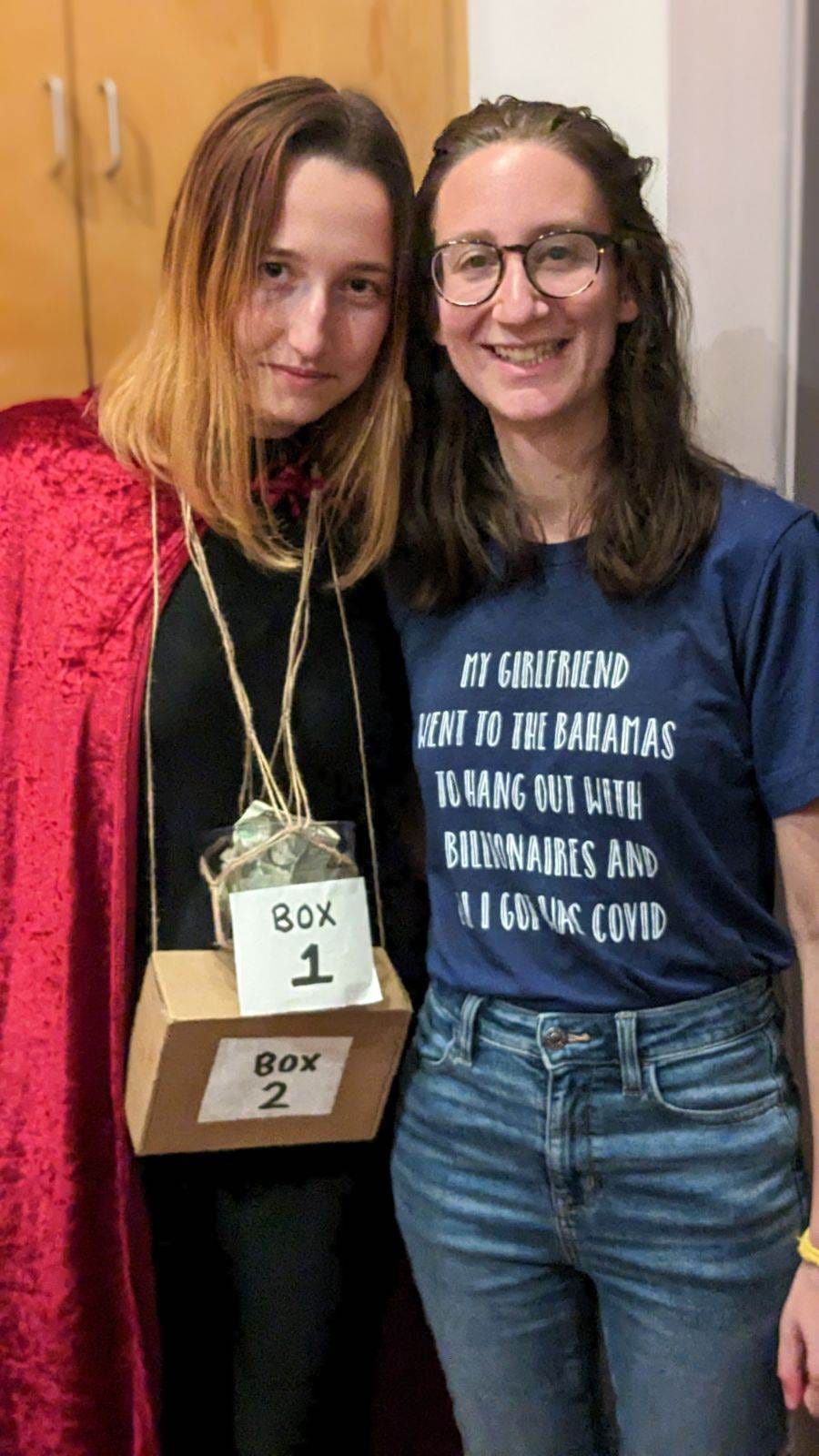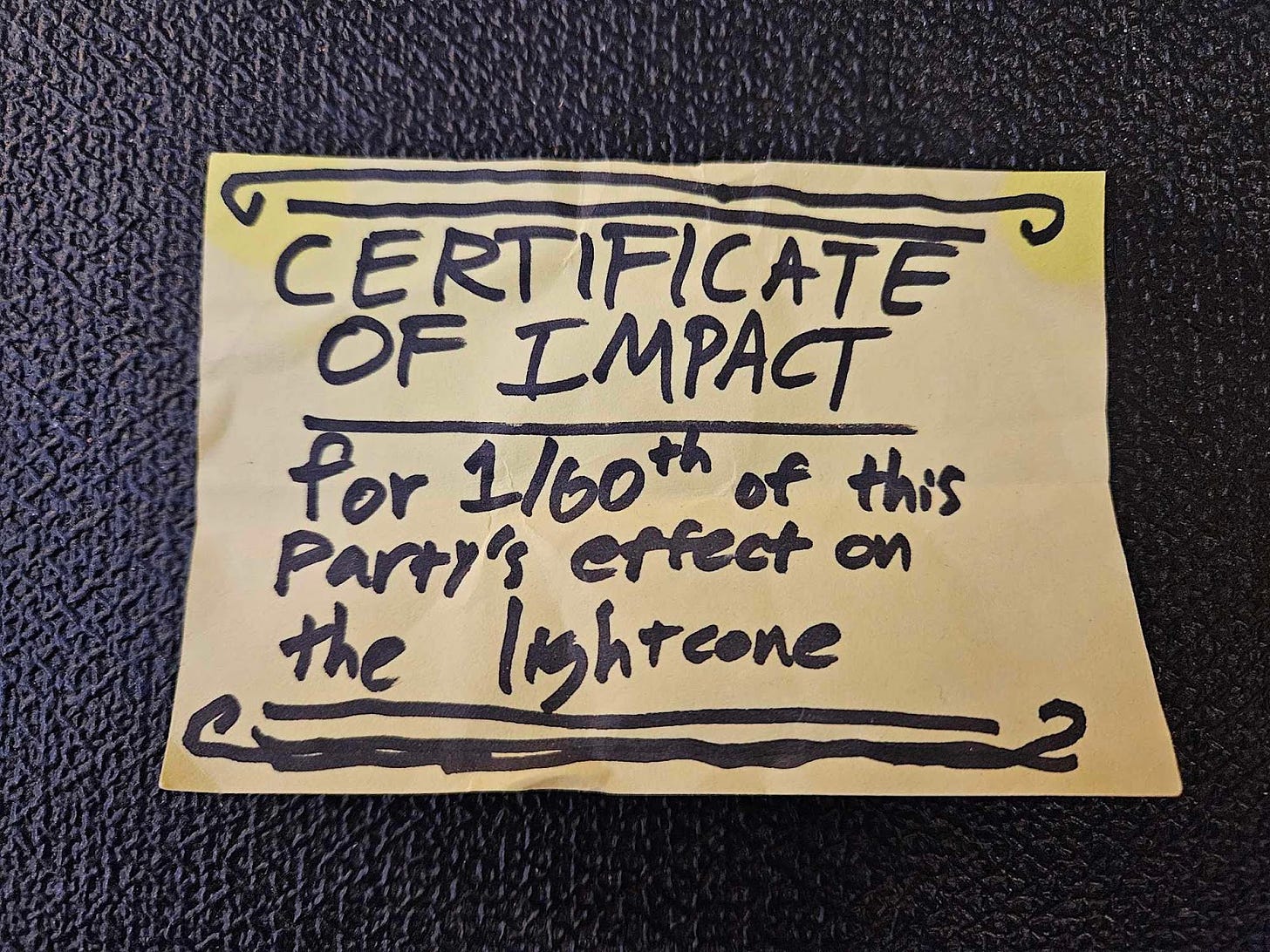With thanks to Scott Alexander for the inspiration, Jeffrey Ladish, Philip Parker, Avital Morris, and Drake Thomas for masterful cohosting, and Richard Ngo for his investigative journalism.
Last summer, I threw an Every Bay Area House Party themed party. I don’t live in the Bay, but I was there for a construction-work-slash-webforum-moderation-and-UI-design-slash-grantmaking gig, so I took the opportunity to impose myself on the ever generous Jeffrey Ladish and host a party in his home. Fortunately, the inside of his house is already optimized to look like a parody of a Bay Area house party house, so not much extra decorating was needed, but when has that ever stopped me?

Richard Ngo recently covered the event, with only very minor embellishments. I’ve heard rumors that some people are doubting whether the party described truly happened, so I’d like to set the record straight. Thus, this is part linkpost, part exegesis, and part shameless promotion of my events for potential future venue-lenders.
The party had 60 attendees, at least according to the Manifold Market on the topic. Upon arrival, partygoers put on tags with their name, professional title, and LessWrong karma. Attendees were also instructed to put on a wristband that successfully communicated their flirting policies. I took the wristband for people who glomarize about their flirting preferences; Richard took the wristband for those who flirt with all and only those who don’t flirt with themselves.
Richard writes:
You scan around the living room, trying to figure out who to talk to first. The host is sitting on the sofa, with two boxes attached to the front of her shirt. One is filled with money, the other empty. A guy next to her is surreptitiously one-boxing, but she presciently slaps his hand away without even looking.
This is defamation. The second box wasn’t (necessarily) empty, and Richard certainly never got the opportunity to look inside it. You might be wondering what was in the box. Unfortunately for you, I glomarize not only about my flirting policies but also about my box contents.
He is correct, though, that I managed to fend off all the surreptitious one-boxers, with the exception of my girlfriend Avital. She still doesn’t know the contents—I would never date someone irresponsible enough to let unknown entities out of a box.

The party was PYOL (provide your own liquidity), but we did offer two punches: one for “Contextualizers,” and one for “Decouplers or Homophobes”. Avital and I drank the punch for “Decouplers or Homophobes.” We’re still coupled, so you can come to your own conclusions about how homophobic we must be.
My favorite part of the night happened when a circle formed around a Jewish Orthodox Rabbi friend of mine who had never heard of Rationality or Effective Altruism. Everyone at the party was eager to give him context. I joined the circle as they were discussing expanding moral circles, and the relative weight of animal lives and future people. “Eliezer doesn’t even think cows are sentient,” one attendee was saying. “But shrimp are!” another interrupted, causing the group to crack up. “What?” my Rabbi friend said.
“Okay, back up, how much Peter Singer have you read?” another attendee said. “Like, have you read Animal Liberation and The Expanding Circle, or just Famine, Affluence, and Morality?” Avital and I tried to explain to them that our friend had not heard of any of the people they were naming, but they didn’t seem to understand. Avital turned to me and said “I guess when you’ve read The Sequences too many times you forget about inferential distance.”
Eventually, my Rabbi friend said “Okay, so what I’m hearing is: you’re expected to tithe 10% of your earnings to charity, you have pilgrimages a few times a year to something called EA Global, and you believe a superhuman power will usher in a new era in which humanity undergoes substantial transformations resulting in either total destruction or universal peace.” Heads nodded. “This… sounds a little like a cult,” he said. “Yes!!” multiple people excitedly shouted at once.

In the other room, the table was covered in various loose sheets of paper, surrounded by hundreds of paperclips. On some of the sheets were contracts for paperclip futures, which had been scattered everywhere for want of a stapler. On others, there was an Estimathon. Drake Thomas and I had spent approximately [20, 199] minutes writing it, but I believe only [1, 9] people ended up playing. Here’s the document, if you want to try your hand at it:
Also on the table were some Certificates of Impact that had been left lying around. At the start of the party, we had given each attendee an index card with 1/n impact certificates (where n would equal the settlement value of the Manifold Market on number of attendees) for the counterfactual impact of the party. So far, the only concrete impact we’ve been able to trace has been Richard’s post, so I guess each attendee is holding a debt worth a few minutes of alignment research.
But Richard reports that we weren’t the only ones in the impact certifying business:
Nearby, two guys are staring despondently at the little strips of paper they’re holding. “God, this is so embarrassing,” one of them says. You crane your neck to have a look. Turns out they’ve both come dressed as impact certifiers. “Want some impact certificates?” one says.
“Sure,” you say.
“How many?”
“Uh… 5 impacts?”
You hadn’t spotted the flogger he was holding in his other hand. He raises it, and says “Great. Hold out your palms.” As you earn your certificates, you sigh; you should have seen that one coming.
I am aghast that an attendee would do this. I mean, handing out impact certificates in exchange for flogging a partygoer? Clearly securities fraud. Especially because the number of impact certificates, much like the partygoer, was unbounded.
Richard ends his post:
On your way home, you decide it’d be worth taking the time to write out a story about the party. After all, while Scott’s title was a bit of an exaggeration, your own account will be a description of every “Every Bay Area House Party” Bay Area house party. And who knows—if people like it enough, maybe it will even inspire a party of its own!
Well, his post has racked up plenty of karma, which is a perfect proxy for whether people liked it. I’ve never repeated a party theme before, but I don’t want to disappoint my fans. Will I host another one? There’s only one way to resolve this:



I actually thought Richard’s post was a joke until I read this. I’m impressed.
The contextualizer/decoupler punch is an outstanding joke.
Wait this was real?! I thought Richard’s post was just a fictional short story.
The LessWrong Review runs every year to select the posts that have most stood the test of time. This post is not yet eligible for review, but will be at the end of 2025. The top fifty or so posts are featured prominently on the site throughout the year.
Hopefully, the review is better than karma at judging enduring value. If we have accurate prediction markets on the review results, maybe we can have better incentives on LessWrong today. Will this post make the top fifty?
I like it better than the usual habit of giving this estimate in years.
Especially, with the mode of https://www.metaculus.com/questions/5121/date-of-artificial-general-intelligence/ being near the border between 2026 and 2027.